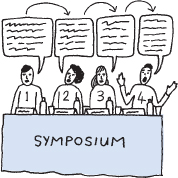Symposium
Printed Page 643
During a symposium, each group member takes responsibility for delivering a different part of the presentation, depending on his or her expertise or interest, or the needs of the group. For example, when a product team at a computer company proposes a design for a new handheld device to its research and development department, one member might describe the competing handheld designs the team used as reference points for its own design. Another member might then present the technical resources that will be required to manufacture the device. And a third member might conclude the presentation by sharing the group’s thoughts about how to minimize the costs of producing the design.

If your group has decided to use this presentation format, plan your symposium carefully. Make sure everyone in the group agrees on the topic each speaker will address and the time he or she will take. Check that all members know what will go into each presentation, so that no one unwittingly repeats points made by someone else (or forgets to mention important ideas).
When you participate in a symposium, avoid speaking longer than your allotted time. Otherwise, subsequent speakers may have insufficient time to deliver their parts of the presentation. Also, treat other speakers’ ideas with respect. If you need to mention points on which group members disagree, present others’ ideas in a professional manner, without judging the individuals advocating those ideas.
As you close your part of the presentation, make sure to briefly introduce the next speaker, making use of any connection between topics in your transition. As a courtesy to both the next speaker and the audience, introduce the speaker by name.
Like a speech by an individual, an effective symposium has an introduction, a body, and a conclusion. In addition to presenting his or her ideas, the first speaker should begin with an introduction that gains the audience’s attention, reveals the topic of the presentation, establishes credibility, connects with the audience, and previews the main idea that each subsequent speaker will develop. The final speaker should conclude by summarizing each presenter’s main idea and leaving the audience with a memorable clincher.